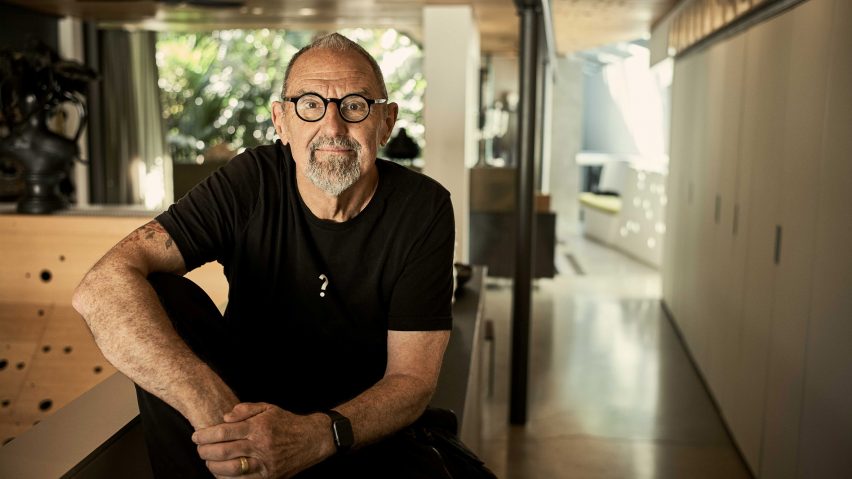
Architects need to "take responsibility for shaping the world" says Thom Mayne
Morphosis founder Thom Mayne, who is reportedly working on Saudi megacity The Line, explained his desire to work on complex, city-scale projects in a talk in New York City.
Speaking at a talk hosted by the AIA at the Center for Architecture in Manhattan, the Pritzker Architecture Prize winner said that his interest in complexity has led him to develop larger projects.
"Unfortunately, I won't be able to show you the two most interesting projects I have, and they're both cities," he said, including "a big planning thing in Saudi Arabia that I can't talk about."
"The scale will keep increasing and we have to keep up with it"
When prompted by architect Winka Dubbeldam, who was moderating the event, to "tell us a little bit about that city of the future without talking about the project", he said:
"The ability to even construct complex organizational ideas, to deal with the huge variability of the issues in the systems [is what] you're doing."
His studio Morphosis is believed to be designing a 170-kilometre-long, mirrored megacity in Saudi Arabia called The Line.
"The scale will keep increasing and we have to keep up with it," said Mayne. "There needs to the advancement of something much more complex, as architects take responsibility for shaping the world."
"And that responsibility comes with risks, like all professions", he continued.
Mayne, who founded Morphosis in 1972, is known for designing governmental and large-scale projects including a supertall skyscraper in Shenzen as well as the San Francisco Federal Building.
To design the more complex projects he believes the world needs, architecture must go beyond "looks" and start to focus on "broader issues" like the relationships to the landscape and to do this will involve AI computation, he said.
"A certain aspect of creativity comes out of the pragmatic world, the scientific world," said Mayne, who wants to promote a question-based approach to architecture that manages complexity while allowing for contingency.
"We need to start thinking like Tesla"
In Mayne's conception, part of dealing with complexity requires balancing pragmatism with randomness and style. He believes that architects need to embrace aspects of the profession beyond design, including interconnectivity and the business of design.
Mayne cited Tesla as an example of a company that focuses on environmental aspects, mechanical efficiency and performance above a product's appearance.
"We have to start thinking like that," he said, referring to architecture as a "collective act".
"Because you cannot isolate design as the look of something," he added. "And it's a dangerous place to be as a professional, right?"
Using the Design Excellence Program and interface with politicians who associate architecture with spending as an example, Mayne said: "Design, we don't want that, no no, no, just capability. Don't even talk about design. That's not really what the issues are."
"Theory more dangerous than it is useful"
Another problem that Mayne spoke on was the outsized focus on theory in concepts in the architectural world.
"I've been suspicious, just by my nature, since I was a kid, of the academic world," he said. "I think theory is maybe more dangerous than it is useful."
"It's a close call," he continued. "Because it leads you away from asking the most important questions of what the issues architecture are."
"I'm a Theodore Roosevelt guy, you've got to get into the arena if you want to make change, if you want to really shape the world."
Mayne also noted his experimentation with AI programs, saying that they could be the key to dealing with the complexity that is confronting contemporary architecture. He said that he is working on "producing the brain" that then produces the work.
"With AI I'm developing a system that develops things that I can look at infinitely," he said. "I'm interested in chance, etc. and infinite opportunities."
AI will "infiltrate" the profession, and he anticipates a decrease in the number of architects in individual studios to a "more intimate" level.
Rumours that Morphosis is working on The Line as they were named in an exhibition about the project alongside Adjaye Associates, Studio Fuksas, Coop Himmelb(l)au and several other studios.
The controversy surrounding The Line has continued since its announcement last year. Human rights organisation ALQST reported that three men forcibly evicted from the site have been sentenced to death.
In an exclusive interview with Dezeen, Amnesty International's Peter Frankental said that any architecture studios involved will be "benefitting" from the human rights abuses at the site.
The photograph is by Kurt Iswarienko and Milenio Mag, courtesy of Morphosis.